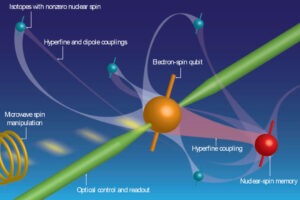Spintronics SRI Stream

Professor Christoph Boehme joined the University of Utah in 2006. His research is focused on the exploration of spin-dependent electronic processes in condensed matter. The goal of his work is to develop sensitive coherent spin motion detection schemes for small spin ensembles that are needed for spintronics, but also quantum information and general-materials spectroscopy applications.
He received the U’s Distinguished Scholarly and Creative Research Award in 2018 for his contributions and scientific breakthroughs in electron spin physics and his leadership in the field of spintronics.
Q: WHAT IS SPINTRONICS?
Modern information technology takes advantage of spintronics (or spin transport electronics) to use the minuscule magnetic fields that emanate from the spin of electrons (similar to the way electronics utilizes the electric charge of electrons) to represent information and to develop faster, smaller information-processing devices that can increase memory or processing capabilities that use less energy or that enable any combination of these improvements.
Conventional digital electronics represent binary information (think 1s and 0s) by the presence of an absence of charge, i.e., electrons in conductive materials. In spintronics devices, information is represented in another way—their spin direction (think up or down). Spintronics, in contrast to electronics, doesn’t require moving electrons around when a 1 is changed to a 0, so it requires less energy. Spin is related to magnetism, so spintronics uses the magnetism of electrons to represent information.

If you’ve ever done the old science experiment of turning a nail into a magnet by repeatedly dragging a magnet along its length, then you’ve already dabbled in spintronics. The magnet transfers information to the nail by aligning the spin of its electrons to the magnetization of the magnet. The trick is then transporting, manipulating, i.e., writing information into spins and, most of all, reading spin information out of spin memory, all of which requires devices and materials with finely tuned properties. The approach pursued in the Boehme group is to study the suitability of various carbon-based semiconductor materials for spintronics device applications.
Q. WHAT MAKES THE U A LEADER IN SPINTRONICS?
For more than a decade, physicists in the Department of Physics & Astronomy have focused on the exploration of spin-dependent electronic processes in condensed matter. Their research has yielded a number of significant discoveries, and their work continues to advance knowledge and understanding of the field.
Q: WHY IS THE PHYSICS SRI PROGRAM IMPORTANT?
Sometimes the most important learning happens by doing. Having an experience in a laboratory-centered, team-based, interdisciplinary environment can give students the skills to succeed as well as access to other opportunities.
Students who participate in the Physics SRI program leave campus with more than a cool college experience; they graduate with the technical expertise to rise to the top of a competitive job market. A physics degree from the U can be a pipeline to Utah’s STEM-based economy. Choosing to participate in the SRI is a great way to forge a path to a rewarding career and an opportunity to enjoy a well-paying job.
The current Department of Physics & Astronomy Spintronics SRI Stream has six undergraduate students under the direction of Dr. Christoph Boehme. Research can be performed for credit, and scholarship opportunities are available.
Research
Science Research Initiative
The Department of Physics & Astronomy at the College of Science offer a Science Research Initiative program in Spintronics.
All interested students are invited to apply for this exciting research program.
